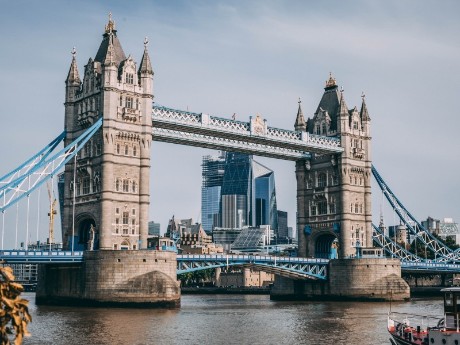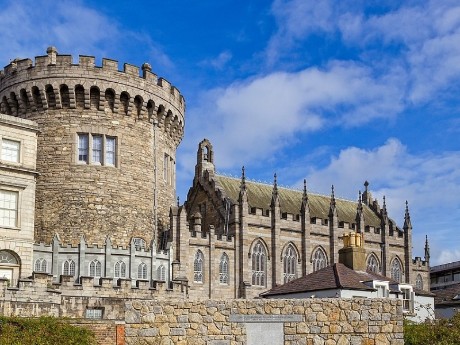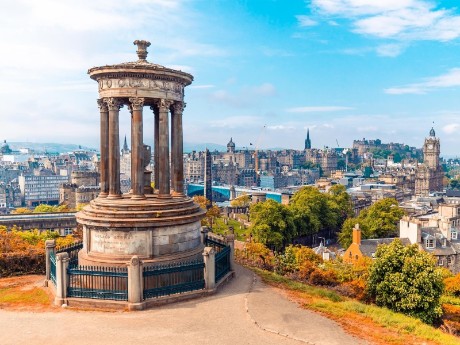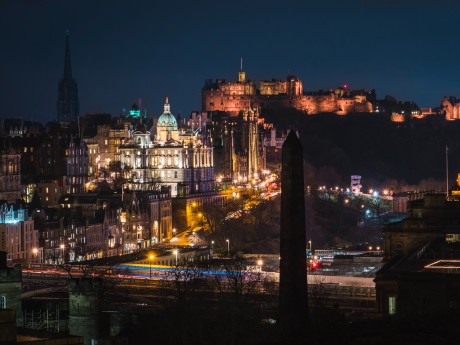England, Ireland & Scotland
Embark on a captivating journey through the UK and Ireland, where you'll uncover the regal grandeur of London's Buckingham Palace, be enchanted by the historic charm of Edinburgh Castle perched atop the Royal Mile, and experience the vibrant energy of Dublin's Temple Bar district as you savour traditional Irish music and cuisine.
Read more
Embark on a captivating journey through the UK and Ireland, where you'll uncover the regal grandeur of London's Buckingham Palace, be enchanted by the historic charm of Edinburgh Castle perched atop the Royal Mile, and experience the vibrant energy of Dublin's Temple Bar district as you savour traditional Irish music and cuisine. In London, immerse yourself in the regal splendour of Buckingham Palace, marvel at the masterpieces in the British Museum, and meander through the charming streets of Covent Garden. Next in Dublin, delight in the literary heritage of Trinity College's Old Library, raise a pint at the iconic Guinness Storehouse, and let the lively tunes of traditional music guide you through the vibrant Temple Bar district. Crossing the Irish Sea, arrive in the enchanting city of Edinburgh, where history comes alive at the imposing Edinburgh Castle, the Royal Mile's cobblestone alleys whisper tales of old, and the panoramic vistas from Arthur's Seat leave you breathless. Waterviews strives to offer accommodation options within walking distance of water and/or in an area of touristic interest. Our prices include taxes (but excludes local tourist taxes). Customize your trip to your personal preferences with optional activities (hit the “Add Activities’’) or change hotels, etc. Contact us for customization at no extra cost at: Service@waterviewstravel.com
Destinations
- London
- Dublin
- Edinburgh
Itinerary
London

A truly global capital city, London is widely recognised for its worldwide influence on music, fashion and culture, as well as politics, trade and finance. As the largest city in Western Europe, London is cosmopolitan and vibrant and is characterised by its diverse and multicultural population. Those looking for history and culture can visit one of its many free museums or classic landmarks which line the cityscape, and for foodies the options are endless, ranging from international street food and markets to fine dining. London has it all.
Read more
A truly global capital city, London is widely recognised for its worldwide influence on music, fashion and culture, as well as politics, trade and finance. As the largest city in Western Europe, London is cosmopolitan and vibrant and is characterised by its diverse and multicultural population. Those looking for history and culture can visit one of its many free museums or classic landmarks which line the cityscape, and for foodies the options are endless, ranging from international street food and markets to fine dining. London has it all.
Additional Information
History
Settlements have existed on the site of London since well before Roman times, with evidence of Bronze Age and Celtic inhabitants. The Roman city of Londinium, established just after the Roman conquest of Britannia in the year 43, formed the basis for the modern city (some isolated Roman period remains are still to be seen within the City). After the end of Roman rule in 410 and a short-lived decline, London experienced a gradual revival under the Anglo-Saxons, as well as the Norsemen, and emerged as a great medieval trading city, eventually replacing Winchester as the royal capital of England. This paramount status for London was confirmed when William the Conqueror, a Norman, built the Tower of London after the conquest in 1066 and was crowned King of England in Westminster.
London went from strength to strength with the rise of England to first European then global prominence, and the city became a great centre of culture, government and industry. London's long association with the theatre, for example, can be traced back to the English renaissance (witness the Rose Theatre and great playwrights like Shakespeare who made London their home). With the rise of Britain to supreme maritime power in the 18th and 19th centuries (see Industrial Britain) and the possessor of the largest global empire, London became an imperial capital and drew people and influences from around the world to become, for many years, the largest city in the world.
England's royal family has, over the centuries, added much to the London scene for today's traveller: the Albert Memorial, Buckingham Palace, Kensington Palace, Royal Albert Hall, Tower of London, Kew Palace and Westminster Abbey being prominent examples.
Despite the decline of the British Empire, and suffering during World War II when London was heavily bombed by the German Luftwaffe in the Blitz, the city remains a top-tier world city: a global centre of culture, finance, and learning. Today London is easily the largest city in the United Kingdom, eight times larger than the second largest, Birmingham, and ten times larger than the third, Glasgow, and dominates the economic, political and social life of the nation. It's full of excellent bars, galleries, museums, parks and theatres. It is also the most culturally and ethnically diverse part of the country, and arguably of the whole of Europe as well, making it a great multicultural city to visit. Samuel Johnson famously said, "when a man is tired of London, he is tired of life". Whether you are interested in ancient history, modern art, opera or underground raves, London has it all.
The City and Westminster
If you ask a Londoner where the centre of London is, you are likely to get a wry smile. This is because historically London was two cities: a commercial city and a separate government capital.
The commercial capital was the City of London. This had a dense population and all the other pre-requisites of a medieval city: walls, a castle (The Tower of London), a cathedral (St Paul's), a semi-independent City government, a port and a bridge across which all trade was routed so Londoners could make money (London Bridge).
About an hour upstream (on foot or by boat) around a bend in the river was the government capital (Westminster). This had a church for crowning the monarch (Westminster Abbey) and palaces. As each palace was replaced by a larger one, the previous one was used for government, first the Palace of Westminster (better known as the Houses of Parliament), then Whitehall, then Buckingham Palace. The two were linked by a road called The "Strand", the old English word for "riverbank".
London grew both west and east. The land to the west of the City (part of the parish of Westminster) was prime farming land (Covent Garden and Soho for example) and made good building land. The land to the east was flat, marshy and cheap, good for cheap housing and industry, and later for docks. Also the wind blows 3 days out of 4 from west to east, and the Thames (into which the sewage went) flows from west to east. So the West End was up-wind and up-market, the East End was where people worked for a living.
Modern-day London in these terms is a two-centre city, with the area in between known confusingly as the West End.
Climate
Despite having perhaps a fair reputation for being unsettled, London enjoys a mild climate on average. As much as one in three days on average will bring rain, though sometimes for only a short period. In some years, 2012 and 2018 being examples, there was no rain for a number of weeks. The fact that Londoners would find this remarkable should be an indication to visitors from drier climates of what they may be in for!
Extreme weather is rare. Occasionally there may be heavy rain that can bring localised flooding or strong winds that may down trees and damage roofs, but overall you are unlikely to encounter anything too lively.
Winter
Winter in London is mild compared to nearby continental European cities due to both the presence of the Gulf Stream and the urban heat effect. The average daily maximum temperature is 8°C (46°F) in December and January. The coldest temperature recorded in London stands at −16.1 °C (3.0 °F) and was recorded at Northolt during January 1962, but this occurred during one of the coldest winters ever seen in the UK.
Daylight hours become increasingly shorter with darkness falling at 15:00 in December. Days continue to be short up until March when sunset starts to occur after 19:00.
Snow does occur, usually a few times a year but rarely heavily (a few years being exceptions such as the winters of 2009 and 2010, with temperatures dipping down to sub-zeros regularly). Snow in London can be crippling, as seen at the end of 2010. Just 7 cm (3 in) of snow will cause trains to stop running, airports to see significant delays, and the postal service to come to a halt. London is a city which does not cope well with snow; walkways, stairs, and streets will not be cleared by shovels or ploughs. The streets will be salted/gritted, but will remain slick and snow/slush covered until the sun melts it away. This is due to a lack of widespread snow-clearing infrastructure as the city does not often see snow.
Spring
Spring in the capital can be something of a weather rollercoaster with big variations in temperature day by day. It can be a very wet time of year, but the increases in day length from March onwards and steady temperature increases as the season progresses can make it a pleasant time to visit.
Days can be mild and warm, but the temperature will often dip at night as the sun's warmth dissipates.
The beginning of spring in March can be as cold as winter, so be sure to bring something warm to wear!
Summer
Summer is perhaps the best season for tourists as it has long daylight hours as well as mild temperatures. The average daily high temperatures in July and August are around 24°C (75°F). The highest temperature ever seen in London stands at 38.1°C (100.6°F), which was recorded on 10 August 2003 at Kew Gardens.
Humidity across the city can increase and stay high over the course of several days and nights, leading to unexpectedly muggy conditions. Also, upon occasion, clouds of dust from storms in the Sahara desert can be blown across Europe and lead to increases in pollution levels.
Despite the increased warmth, the weather in summer can be variable. Occasional prolonged instances of rain and unexpected dips in temperature can occur. If you're coming during the summer it is still advised to dress in layers and bring some waterproofs!
Autumn
Autumn in London can vary from year to year: In some years September and October can see temperatures not far below those seen in summer due to a phenomenon known as an "Indian summer", but in other years the temperature can decrease rapidly to winter levels and stay there. Autumn tends to be the wettest and windiest season but, again, this can vary from year to year. Day length at the beginning of autumn is near that of summer, meaning that a September trip can still be as easy to plan as an August one as there's plenty of daylight to work with.
Mid-autumn is a wonderful time to wander one of London's many tree-filled parks as the leaves fade from green to gold. Another benefit of a September trip is that children return to school at the beginning of the month, meaning that some tourist attractions will be quieter.
It's best to see autumn in London as being like a box of chocolates: You never know what you're going to get!
Tourist information centres
London has no centrally located tourist information centre. The City of London Information Centre, as the last remaining information centre in any of the Central London boroughs, is now the only impartial, face-to-face source of tourist information in Central London. It is located in St. Paul's Churchyard, next to St. Paul's Cathedral, and is open every day other than Christmas Day and Boxing Day, M-Sa 09:30-17:30 and Su 10:00-16:00. There is no office for tourist information for the UK or for England.
© Sourced from Wikivoyage
Dublin

The vibrant, world-renowned capital of Ireland is an essential stop in any visit to the country. Dublin is a dynamic hub buzzing with life, and offers something for every traveller with its mixture of historical buildings and modern architecture within a compact city centre. Spend the day visiting museums and learning about Ireland’s literary legends, before sampling some of the famous Irish charm in one of Dublin’s many pubs and enjoying some live music while chatting to friendly and welcoming locals over a Guinness or two.
Read more
The vibrant, world-renowned capital of Ireland is an essential stop in any visit to the country. Dublin is a dynamic hub buzzing with life, and offers something for every traveller with its mixture of historical buildings and modern architecture within a compact city centre. Spend the day visiting museums and learning about Ireland’s literary legends, before sampling some of the famous Irish charm in one of Dublin’s many pubs and enjoying some live music while chatting to friendly and welcoming locals over a Guinness or two.
Additional Information
History
Founded in 841, Dublin was originally settled by Vikings among a population of Celtic tribes. In the 9th century the Danes captured Dublin and had control until 1171 when they were expelled by King Henry II of England. By the 14th century the king of England controlled Dublin and the surrounding area referred to as “the Pale”.
When the English Civil War ended in 1649, Oliver Cromwell took over. Dublin experienced huge growth and development in the 17th century because many Protestant refugees from Europe came to Dublin. By the 17th century Dublin was the second largest city in the British Isles, only behind London, and a period when great Georgian style buildings were constructed that still stand today. Georgian style architecture was popular from 1720 to 1840 during the times when George I, George II, George III, and George IV of England were ruling.
In 1800, the Act of Union between England and Ireland abolished the Irish Parliament. From this point on, the Irish worked to gain their independence from England, which they finally won in 1922. The Easter rising in 1916 and the War of Independence greatly helped Ireland win their freedom.
A failed attempt to take over the several important buildings, among them the General Post Office on O'Connell Street, led to the arrest of hundreds and execution of 15, now considered martyrs for the cause. Many believe that this event helped gain sympathy for the fight for independence from Britain.
Orientation
Dublin is divided by the River Liffey. On the north side of the Liffey is O'Connell Street — the main thoroughfare, which is intersected by numerous shopping streets, including Henry Street and Mary Street, the busiest shopping district in the city. On the south side are St. Stephen's Green and Grafton Street, the second busiest and most upmarket shopping area, Trinity College, Christ Church and St. Patrick's Cathedrals, the main branch of the National Museum, and many other attractions.
Dublin postal districts range from Dublin 1 to Dublin 24. As a rule, odd numbers are given to areas north of the River Liffey, while even numbers are given to areas south of the river (exceptions are Dublin 8 and 20 which span both sides of Liffey). Usually, the lower the district number, the closer to the city centre.
Although some of Dublin's finest Georgian architecture was demolished in the mid-20th century, a remarkable amount remains. At one point these buildings were considered a reminder of the past British imperialism and many were demolished without regard to their beauty and architectural significance and replaced with modernist or pastiche office blocks, parts of St. Stephen's Green (Dublin 2) being a prime example. Thankfully, attitudes have changed significantly, and Dubliners are now rightly proud of their impressive buildings from all eras.
© Sourced from Wikivoyage
Edinburgh

Scotland's capital is steeped in charm, with monuments, historic buildings and picturesque views on every corner. Set between rolling hills and the waters of the Firth of Forth, Edinburgh has something to offer for everyone, with rich culture, enchanting history and scenic nature right on your doorstep. Stroll through the narrow, cobbled lanes of the Old Town, climb up to the ancient castle that sits atop a craggy rock or head to the elegant avenues of the bustling New Town where countless museums, galleries, restaurants and cafes await.
Read more
Scotland's capital is steeped in charm, with monuments, historic buildings and picturesque views on every corner. Set between rolling hills and the waters of the Firth of Forth, Edinburgh has something to offer for everyone, with rich culture, enchanting history and scenic nature right on your doorstep. Stroll through the narrow, cobbled lanes of the Old Town, climb up to the ancient castle that sits atop a craggy rock or head to the elegant avenues of the bustling New Town where countless museums, galleries, restaurants and cafes await.





